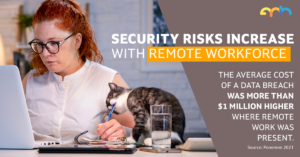How to Ensure Compliance When Working Remotely

Many businesses have adopted remote or hybrid work models to sustain their operations. While these models offer numerous advantages, they also introduce new cybersecurity and compliance challenges. Cybercriminals target vulnerable home networks, and remote employees often save files on local drives, putting proprietary data at risk.
Small businesses should never underestimate the importance of cybersecurity. In this blog post, we will delve into the significant compliance and security concerns associated with remote work and explore strategies to address them. Despite the escalating cyber threats, businesses can effectively combat these challenges and maintain regulatory compliance, even with a remote workforce.
Security and Compliance Challenges of Remote Work:
While many companies have embraced remote or hybrid work, only a few have established robust policies and processes to support secure remote work. Even large corporations struggle to maintain compliance standards as their employees work from home. Here are the key challenges faced by businesses of all sizes when dealing with remote employees:
- Reduced Security: Today, employees often use business devices on their home networks and occasionally use personal devices for work. This lack of control over security poses a significant threat to business data.
- Inability to Enforce Best Practices: In the office environment, organizations can ensure that employees follow data security best practices. However, with remote work, employees might use shared networks or public Wi-Fi, complicating security measures.
- Inadequate Backup: Data backup failures are common. Organizations must ensure they have multiple copies of critical data to safeguard against potential compromises of remote servers.
- Lack of Employee Awareness: Despite following best practices for data handling, human error remains a significant security and compliance threat. Remote employees need proper awareness training on data handling and best practices.
Best Practices to Ensure Compliance During Remote Work:
Despite the inherent challenges of remote work, organizations can adopt the following best practices to enhance security and maintain compliance with various regulations:
- Create a Cybersecurity Policy: Establish a cybersecurity policy tailored for remote work, outlining the steps employees should follow at personal and professional levels. Setting standards and best practices for cybersecurity minimizes risk exposure.
- Implement a Consistent Data Storage Policy: Introduce a standardized cloud storage policy to guide employees on data storage and handling. Maintaining a shared cloud repository for file backups prevents inconsistencies and enhances data security.
- Enhance Remote Monitoring: Deploy robust remote monitoring solutions that automate endpoint management and enforce cybersecurity policies. Complete visibility into the remote working network helps mitigate vulnerabilities and security threats.
- Increase Employee Awareness Through Training: Provide remote-working employees with comprehensive training on cybersecurity best practices, such as identifying suspicious links, exercising caution with untrusted messages, using strong passwords, and implementing multifactor authentication.
- Use the Right Tools and Solutions: Combat evolving cyber threats with effective software tools, including remote monitoring, antivirus software, cloud backup, and password managers. Ensure seamless integration of these solutions into a comprehensive platform.
What Businesses Need Today:
Ensuring compliance is a paramount task, particularly when implementing remote work policies and procedures. Investing in a security solution that safeguards valuable data and meets compliance regulations in a remote work environment is essential. Explore our checklist for insights on complying with security best practices for both traditional and hybrid workforce models.
Contact us today, and we can assist you in devising an effective compliance strategy tailored to your specific needs.

